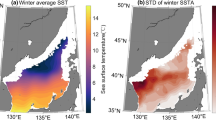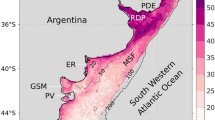Abstract
We investigated the phase difference and the cross correlation coefficient between the band-pass filtered biennial variations of sea surface temperature (SST) and air-sea heat flux estimated by the monthly mean 2°×2° satellite data of Advanced Very High Resolution Radiometer (AVHRR) and Special Sensor Microwave/Imager (SSM/I) from July 1987 to June 1991. Judging from the phase difference, it can be determined whether the biennial variation of SST is controlled by local thermal air-sea interaction or oceanic processes of horizontal transport. When the local air-sea heat flux controls the biennial variation of SST, the phase of SST advances π/2 (∼6 months) against that of the air-sea heat flux. In contrast, when the biennial variation of SST is controlled by the oceanic process, the phase difference between the SST and the air-sea heat flux becomes 0 or π(∼12 months). In this case, two types of the phase differences are determined, depending on which variability of SST and air-sea heat flux is larger. The close thermal air-sea interaction is noticeable in the tropics and in the western boundary current region. The phase difference of π/2 appears mainly in the north Pacific, the southeast Indian Ocean, and the western tropical Pacific; zero in the eastern tropical Pacific and the northeast and equatorial Atlantic; and that of π in the central equatorial Pacific and north of the intertropical convergence zone (ITCZ) of the Atlantic. Phase differences of 0, π, or π/2 are possible in the western boundary current regions. This fact indicates that each current plays a different role to the biennial variation of SST. It is inferred that SST anomalies in the tropics are mutually correlated, and the process in which marked SST anomalies in the tropics are transferred to the remote area was probed. In the equatorial Pacific, the SST anomaly is transferred by the long planetary wave. On the other hand, it is found from the phase relationship and the horizontal correlation of SST that the SST anomaly in the central and western equatorial Pacific is connected through atmospheric mediation. It is suggested that the biennial variation of SST in the eastern Indian Ocean is affected by heat transport due to the Indonesian throughflow from the western tropical Pacific. It is found that the mentioned pattern of the interannual variation of SST in the tropical Atlantic as a dipole is not tenable.
Similar content being viewed by others
References
Barnett, T. P. (1991): The interaction of multiple time scales in the tropical climate system.J. Climate,4, 269–285.
Brady, E. C. (1994): Interannual variability of Meridional transport in a numerical model of the upper equatorial Pacific Ocean.J. Phys. Oceanogr.,24, 2675–2694.
Gill, A. E. (1982):Atmosphere-Ocean Dynamics. Academic Press, 666 pp.
Godfrey, J. S. (1989): A Sverdrup model of the depth—integrated flow for the ocean allowing for island circulations.Geophys. Astrophys. Fluid Dyn.,45, 89–112.
Godfrey, J. S. and E. J. Lindstrom (1989): Budget of the equatorial western Pacific surface mixed layer.J. Geophys. Res.,94, 8007–8017.
Graham, N. E. and T. P. Barnett (1987): Sea surface temperature, surface wind divergence, and convection over tropical oceans.Science,238, 657–659.
Halpert, M. S. and C. F. Ropelewski (1992): Surface temperature patterns associated with the southern oscillation.J. Climate,5, 577–593.
Hastenrath, S. (1991):Climate Dynamics of the Tropics, Kluwer Academic Publishers, 488 pp. (see Figure 6.7.2.1:4).
Hastenrath, S. and L. Heller (1977): Dynamics of climatic hazards in northeast Brazil.Quart. J. R. Met. Soc.,103, 77–92.
Hirst, A. C. and S. Hastenrath (1983): Atmosphere-ocean mechanisms of climate anomalies in the Angola—tropical Atlantic sector.J. Phys. Oceanogr.,13, 1146–1157.
Houghton, R. W. (1991): The relationship of sea surface temperature to thermocline depth at annual and interannual time scales in the tropical Atlantic Ocean.J. Geophys. Res.,96, 15173–15185.
Houghton, R. W. and Y. M. Tourre (1992): Characteristics of low-frequency sea surface temperature fluctuations in the tropical Atlantic.J. Climate,5, 765–771.
Joseph, P. V., J. K. Eischeid and R. J. Ptyle (1994): Internannual variability of the onset of the Indian summer monsoon and its association with atmospheric features, El Niño, and sea surface temperature anomalies.J. Climate,7, 81–105.
Konda M., N. Imasato, K. Nishi and T. Toda (1994): Measurement of the sea surface emissivity.J. Oceanogr.,50, 17–30.
Konda, M., N. Imasato and A. Shibata (1996): A new method to determine near-sea surface air temperature by using satellite data.J. Geophys. Res.,101, 14349–14360.
Kutsuwada, K. (1991): Quasi-periodic variabilities of wind-stress fields over the Pacific ocean related to ENSO events.J. Meteor. Soc. Japan,69, 687–700.
Large, W. G. and S. Pond (1982): Sensible and latent heat flux mesurements over the ocean.J. Phys. Oceanogr.,12, 464–482.
Lau, K. M. and P. H. Chan (1988): Intraseasonal and interannual variations of tropical convection: a possible link between the 40–50 day oscillation and ENSO?J. Atmos. Sci.,45, 506–521.
Legecks, R. (1988): Upwelling off the gulfs of Panama and Pagagayo in the tropical Pacific during March 1985.J. Geophys. Res.,93, 15485–15489.
Liu, W. T. (1986): Statistical relation between monthly mean precipitable water and surface-level humidity over global oceans.Mon. Weather Rev.,114, 1591–1602.
Liu, W. T. and C. Gautier (1990): Thermal forcing on the tropical Pacific from satellite data.J. Geophys. Res.,95, 13209–13217.
Liu, W. T., A. Zhang and K. B. Bishop (1994): Evaporation and solar irradiance as regulators of sea surface temperature in annual and interannual changes.J. Geophys. Res.,99, 12623–12637.
Lukas, R. and E. Lindstrom (1991): The mixed later of the western equatorial Pacific ocean.J. Geophys. Res.,96, Suppl., 3343–3357.
McClain, E. P., W. G. Pichel and C. C. Walton (1985): Comparative performance of AVHRR-based multichannel sea surface temperatures.J. Geophys. Res.,90, 11587–11601.
McPhaden, M. J. (1982): Variability in the central equatorial Indian Ocean part I: ocean dynamics.J. Mar. Res.,40, 157–176.
McPhaden, M. J. and S. P. Hayes (1991): On the variability of winds, sea surface temperature, and surface layer heat content in the western equatorial Pacific.J. Geophys. Res.,96, 3331–3342.
McPhaden, M. J., H. P. Freitag, S. P. Hayes, B. A. Taft and K. Wyrtki (1988): The response of the equatorial Pacific ocean to a westerly wind burst in May 1986.J. Geophys. Res.,93, 10589–10603.
McPhaden, M. J., S. P. Hayes, L. J. Mangum and J. M. Toole (1990): Variability in the western equatorial Pacific ocean during the 1986–87 El Niño/Southern Oscillation event.J. Phys. Oceanogr.,20, 190–208.
McPhaden, M. J., F. Bahr, Y. Du Penhoat, E. Firing, S. P. Hayes, P. P. Niiler, P. L. Richardson and J. M. Toole (1992): The response of the western equatorial Pacific ocean to westerly wind bursts during November 1989 to January 1990.J. Geophys. Res.,97, 14289–14303.
Meehl, G. A. (1987): The annual cycle and interannual variability in the tropical Pacific and Indian Ocean regions.Mon. Weather Rev.,115, 27–50.
Meehl, G. A. (1993): A Coupled air-sea biennial mechanism in the tropical Indian and Pacific regions: role of the ocean.J. Climate,6, 31–41.
Miyama, T., T. Awaji, K. Akitomo and N. Imasato (1995): Study of seasonal transport variations in the Indonesian seas.J. Geophys. Res.,100, 20517–20541.
Moura, A. D. and J. Shukla (1981): On the dynamics in northeast Brazil: observations, theory and numerical experiments with a general circulation model.J. Atmos. Sci.,38, 2653–2675.
Murakami, T., B. Wang and S. W. Lyons (1992): Constants between summer monsoons over the bay of Bengal and the eastern north Pacific.J. Meteor. Soc. Japan,70, 191–210.
Murray, S. P. and D. Arief (1988): Throughflow into the Indian ocean through the Lombok Strait, January 1985–Juanuary 1986.Nature,333, 444–447.
Nykjær, L. and L. van Camp (1994): Seasonal and internnual variability of coastal upwelling along northwest Africa and Portugal from 1981 to 1991.J. Geophys. Res.,99, 14197–14207.
Rasmusson, E. M. and T. H. Carpenter (1982): Variations in tropical sea surface temperature and surface wind fields associated with the southern oscillation/El Niño.Mon. Weather Rev.,10, 354–384.
Ropelewski, C. F., M. S. Halpert and X. Wang (1992): Observed tropospheric biennial variability and its relationship to the southern oscillation.J. Climate,5, 594–614.
Semtner, A. J. and R. M. Chelvin (1992): Ocean general circulation from a global eddy—resolving model.J. Geophys. Res.,97, 5493–5550.
Servain, J. (1991): Simple climatic indices for the tropical Atlantic Ocean and some applications.J. Geophys. Res.,96, 15137–15146.
Shinoda, T. and R. Lukas (1995): Lagrangian mixed layer modeling of the western equatorial Pacific.J. Geophys. Res.,100, 2523–2541.
Siedler, G., N. Zangenberg and R. Onken (1992): Seasonal changes in the tropical Atlantic circulation: observation and simulation of the Guinea Dome.J. Geophys. Res.,97, 703–715.
Smith, S. D. (1980): Wind stress and heat flud over the ocean in gale force winds.J. Phys. Oceanogr.,10, 709–726.
Sprintall, J. and M. J. McPhaden (1994): Surface layer variations observed in multiyear time series measurements from the western equatorial Pacific.J. Geophys. Res.,99, 963–979.
Stramma, L. (1992): The South Indian Ocean Current.J. Phys. Oceanogr.,22, 421–430.
Umatami, S. and T. Yamagata (1991): Response of the eastern tropical Pacific to meridional migration of the ITCZ: The generation of the Costa Roca dome.J. Phys. Oceanogr.,21, 346–363.
Waliser, D. E., B. Blanke, J. D. Neelin and C. Gautier (1994): Shortwave feedbacks and El Niño-Southern Oscillation: forced ocean and coupled ocean-atmosphere experiments.J. Geophys. Res.,99, 25109–25125.
Wang, X. L. (1994): The coupling of the annual cycle and ENSO over the tropical Pacific.J. Atmos. Sci.,51, 1115–1136.
Weare, B. (1977): Empirical orthogonal analysis of Atlantic Ocean surface temperatures.Quart. J. R. Met. Soc.,103, 467–478.
Zebiak, S. E. (1993): Air-sea interaction in the equatorial Atlantic region.J. Climate,6, 1567–1586.
Zhang, G. J. and M. J. McPhaden (1995): The relationship between sea surface temperature and latent heat flux in the equatorial Pacific.J. Climate,8, 589–605.
Zhang, R. H. and M. Endoh (1994): Simulation of the 1986–87 El Niño events with a free surface tropical Pacific Ocean general circulation model.J. Geophys. Res.,99, 7743–7759.
Author information
Authors and Affiliations
Rights and permissions
About this article
Cite this article
Konda, M., Imasato, N. & Shibata, A. Analysis of the global relationship of biennial variation of sea surface temperature and air-sea heat flux using satellite data. J Oceanogr 52, 717–746 (1996). https://doi.org/10.1007/BF02239462
Received:
Revised:
Accepted:
Issue Date:
DOI: https://doi.org/10.1007/BF02239462




